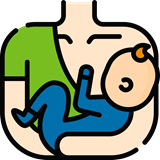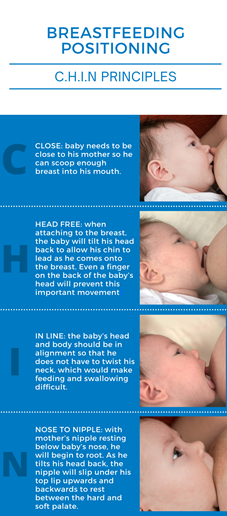When learning how to breastfeed, getting the position and attachment right will help make feeding more comfortable. It will support you to establish a good milk supply and help your baby to thrive.
For some mums and babies, breastfeeding may appear easier and more natural, but most will find it challenging at some point.
With the right support, you and your baby can figure out how to do it together. Many challenges can often be overcome if you and your baby can achieve good attachment and positioning.
Getting Ready
Before you begin feeding, make sure that you and you baby are both comfortable. Here are a few things you can do when you are getting ready to breastfeed your baby;
 Try to get everything you need, like a cold drink, food, change of breast pads or muslin, to hand before you start.
Try to get everything you need, like a cold drink, food, change of breast pads or muslin, to hand before you start.Remember - Always bring your baby to the breast… rather than bending to bring your breast to baby.
For your baby to feed well they need to have a good latch onto your nipple. You can do this by;
If your baby is not attached properly they may not take enough breast into their mouth. This can become painful and they may not take in enough milk.
Knowing When You Have a Good Latch
It can be hard to tell if your baby is feeding properly, but here are a few signs that will indicate they have a good latch.
C.H.I.N Principles
 CHIN principles help you correctly position your baby when breastfeeding
CHIN principles help you correctly position your baby when breastfeeding
C: Close
Baby needs to be close to his mother so he can scoop enough breast into his mouth.
H: Head Free
When attaching to the breast the baby will tilt his head back to allow his chin to lead as he comes onto the breast. Even a finger on the back of the baby's head will prevent this important movement.
I: In Line
The baby's head and body should be in alignment so that he does not have to twist his neck, which would make feeding and swallowing difficult.
N: Nose to Nipple
With mother's nipple resting below baby's nose he will begin to root. As he tilts his head back the nipple will slip under hi s top lip upwards and backwards to rest between the hard and soft palate.
Unicef Breastfeeding Masterclass Video
You may find that you need to get more support if you see some of these signs;
If you feel that something isn't right, ask a midwife or breastfeeding champion for help if you need to.
If you are confident that your baby’s positioning and attachment is good but you feel your baby is still struggling to feed, please call Just One Number on 0300 300 0123. You can ask for one of our infant feeding champions to contact you.
If your baby is less than 28 days old you can contact your local midwifery team or you can contact the Healthy Child Programme at any time following your baby's birth by calling Just One Number on 0300 300 0123 or texting Parentline on 07520 631590.
Our opening hours are 8am-6pm Monday to Friday (excluding bank holidays) and 9am-1pm on Saturdays.
Norfolk Healthy Child Programme has a team of infant feeding champions who can contact you by video call/telephone initially to discuss your questions and refer you to further help if required. All of our staff are trained to Unicef standards to provide you with the best possible breastfeeding support and advice.
It may help in the first instance to read the Essential Guide to Feeding & Caring for your Baby.
Norfolk’s Early Childhood and Family Service (ECFS) offers support for all parents and carers with children aged 0 to 5 years.
To speak to other Norfolk parents and carers, you can join our online community forum below.
Also in this section...